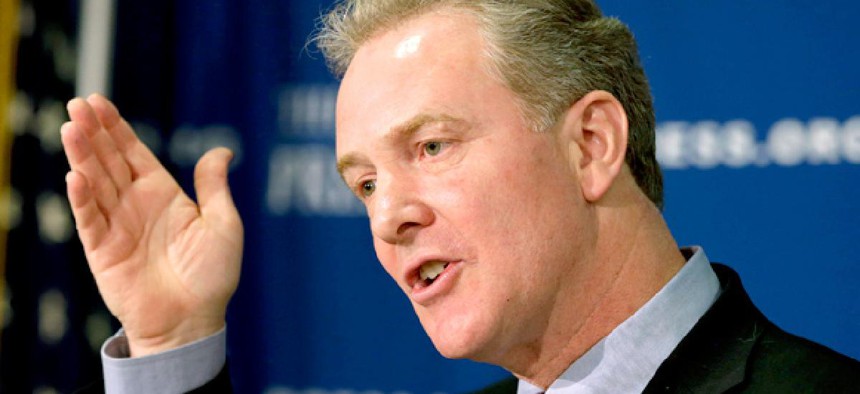
Rep. Chris Van Hollen, D-Md. Jacqueline Martin/AP
House Democratic Budget Proposal Replaces Sequester
Van Hollen: Sequester is likely with us for now, but we’ll keep trying to get rid of it.
House Democrats would replace sequestration with a mix of targeted spending cuts and increased tax revenue to balance the budget by 2040, according to the fiscal 2014 proposal they unveiled on Monday.
Rep. Chris Van Hollen, D-Md., said Democrats would keep pressing to replace the sequester this year and beyond, despite the fact that both the House and Senate maintained the automatic spending cuts in their legislation to keep the government open through Sept. 30. The House already has passed a continuing resolution, and the Senate is expected to approve its version this week.
Van Hollen acknowledged, however, that rescinding the sequester for the rest of fiscal 2013 would be difficult. “In the very short term, the sequester appears to be remaining in place, and it is every day doing more damage to the economy,” he said during a conference call with reporters. He said there will be more momentum to unwind sequestration as people begin to see its negative impacts.
The ranking member of the Budget Committee said the “big question” over whether the sequester will remain in place is if leaders can forge a “larger agreement” or so-called grand plan between now and August.
The Democrats’ alternative to the GOP fiscal 2014 budget proposal, offered as a substitute amendment to Wisconsin Republican Paul Ryan’s resolution focuses on creating jobs, in large part, by replacing the sequester. Van Hollen, citing the nonpartisan Economic Policy Institute, said the Democrats’ plan would generate 1.2 million jobs this year “compared to the Republicans’ European-style austerity plan,” partly by saving the 750,000 estimated jobs that will be lost because of sequestration.
The sequester won’t just lay off or furlough workers, Van Hollen said, but it will also prevent new jobs from being created. The Maryland Democrat has offered several unsuccessful proposals over the last few months to replace the mandatory, across-the-board spending cuts that went into effect on March 1.
The differences between the Republican and Democratic budget plans are vast. Ryan’s blueprint focuses on balancing the budget in 10 years through reforming the tax code and entitlement programs, reducing the federal workforce and eliminating duplicative government programs and inefficiencies; Democrats want to raise taxes on high-income earners and invest billions in an education jobs initiative, clean energy, transportation and infrastructure. The GOP blueprint also would not replace the sequester, and would extend the spending caps outlined in the 2011 Budget Control Act to last two years longer than originally planned, through 2023.
Unlike Ryan’s plan, Van Hollen’s alternative does not include proposals to increase the amount federal employees contribute to their pensions, or to change their pay. The GOP plan also calls for reducing the federal workforce through attrition by 10 percent by 2015; the Democratic proposal said such an “indiscriminate” cut to the civilian workforce would “adversely affect security agencies, leaving them unable to manage their total workforce, which includes contractors, and their operations in a cost-effective manner.”
Democrats argued that the increase in the federal workforce since 2001 is largely at security-related agencies, like the Defense and Homeland Security departments. Their budget outline proposes to cut defense spending by $200 billion from pre-sequester levels over the next decade, in part by identifying waste and reforming the acquisition process.
Van Hollen also said the Democratic plan would raise revenue by $1.2 trillion over the next decade by closing tax loopholes and eliminating some tax breaks for high-income earners. He said the proposal would reduce the deficit to 2.4 percent of the Gross Domestic Product in 10 years.
The House this week will consider and vote on a fiscal 2014 budget resolution before lawmakers recess for the Easter-Passover holidays on Thursday.
NEXT STORY: Labor Nominee Draws Union Praise, GOP Wariness







